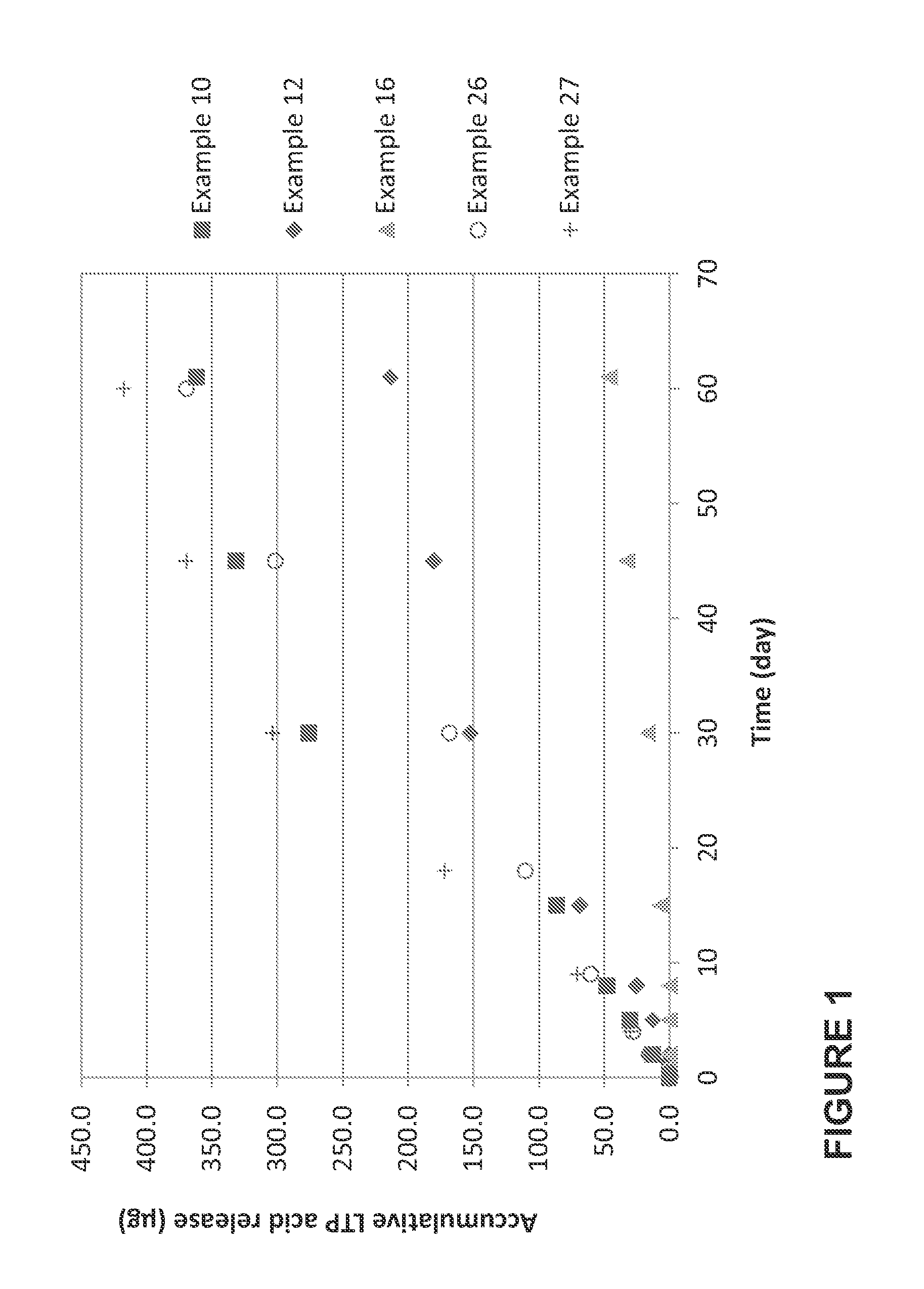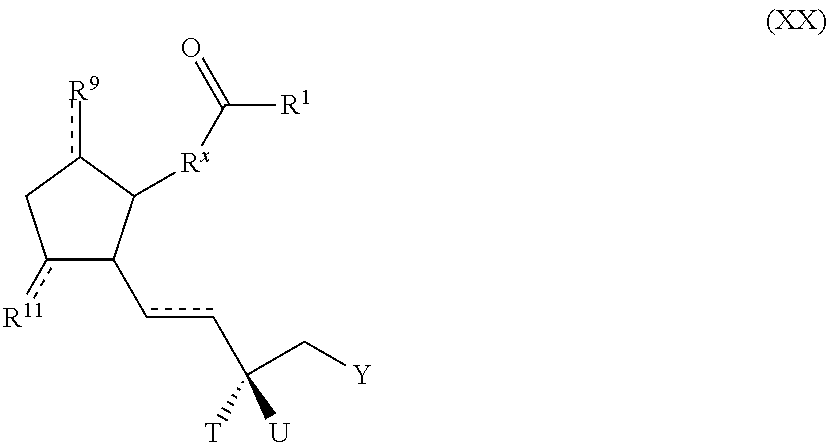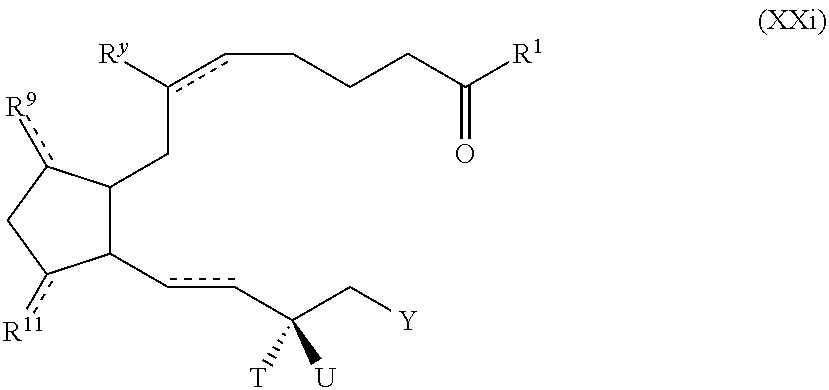Polymer conjugated prostaglandin analogues
a technology of prostaglandins and polymers, applied in the field of polymerdrug conjugates, can solve the problems of large device for convenient administration, significant change in the physical properties of the admixture, and poor control of the release of the drug, and achieve the effect of effective and efficient means
- Summary
- Abstract
- Description
- Claims
- Application Information
AI Technical Summary
Benefits of technology
Problems solved by technology
Method used
Image
Examples
example 1
(Z)-3-Hydroxy-2-(hydroxymethyl)-2-methylpropyl 7-((1R,2R,3R,5S)-3,5-dihydroxy-2-((R)-3-hydroxy-5-phenylpentyl)cyclopentyl)hept-5-enoate (2)
[0580]
[0581]The general procedure for HBTU coupling (Procedure 1) was followed using latanoprost free acid (1) (407.1 mg, 1.0 mmol), HBTU (440.3 mg, 1.2 mmol), 1,1,1-trishydroxymethyl ethane (187.9 mg, 1.6 mmol) and triethylamine (0.60 mL, 4.3 mmol) in anhydrous THF. The residue was chromatographed (SiO2, MeOH—CHCl3, 10:90) to give the title compound (2) (322.0 mg, 63% yield) as a clear colourless oil. ESI-MS: m / z 538 ([M+2Na]+); 1H NMR (400 MHz, CDCl3) δ (ppm): 7.34-7.16 (m, 3H), 7.16-7.00 (m, 2H), 5.43-5.36 (m, 1H), 5.35-5.18 (m, 1H), 4.16-3.97 (m, 2H), 3.89-3.74 (m, 1H), 3.61-3.51 (m, 1H), 3.45 (s, 3H), 3.41-3.31 (m, 4H), 2.80-2.65 (m, 2H), 2.65-2.46 (m, 2H), 2.40-1.96 (m, 5H), 1.91-1.35 (m, 8H), 1.35-1.20 (m, 2H), 0.77 (s, 2H).
example 2
(Z)-1,3-Dihydroxypropan-2-yl 7-((1R,2R,3R,5S)-3,5-dihydroxy-2-((R)-3-hydroxy-5-phenylpentyl)cyclopentyl)hept-5-enoate (5)
[0582]
[0583]The general procedure for HBTU coupling (Procedure 1) was followed, using latanoprost free acid (1) (528.2 mg, 1.35 mmol), 1,3-benzylidene glycerol (309.0 mg, 1.71 mmol), HBTU (564.5 mg, 1.49 mmol) and triethylamine (0.8 mL, 5.75 mmol) in anhydrous DCM. The crude material was chromatographed (SiO2, EtOAc, 100%) to give the benzylidene ester (3) (412.3 mg, 55% yield) as a clear colourless oil. ESI-MS: m / z 575 ([M+Na]+); 1H NMR (400 MHz, CDCl3) δ (ppm): 7.49-7.37 (m, 2H), 7.37-7.24 (m, 3H), 7.24-7.16 (m, 2H), 7.16-7.03 (m, 3H), 5.48 (s, 1H), 5.41-5.31 (m, 4H), 4.70-4.57 (m, 1H), 4.26-3.94 (m, 5H), 3.90-3.69 (m, 1H), 3.81-3.82 (m, 1H), 2.77-2.64 (m, 1H), 2.62-2.54 (m, 1H), 2.38 (td, J=7.2, 1.2 Hz, 3H), 2.30-1.98 (m, 6H), 1.82-1.35 (m, 10H), 1.35-1.13 (m, 2H).
[0584]The general procedure for benzylidene deprotection (Procedure 2) was followed using the benz...
example 3
1,3-Dihydroxypropan-2-yl 4-(((Z)-7-((1R,2R,3R,5S)-3,5-dihydroxy-2-((R)-3-hydroxy-5-phenylpentyl)cyclopentyl)hept-5-enoyl)oxy)benzoate (6)
[0585]
[0586]The general procedure for HBTU coupling (Procedure 1) was followed, using latanoprost free acid (1) (234.1 mg, 0.60 mmol), 2-phenyl-1,3-dioxan-5-yl 4-hydroxybenzoate (361.5 mg, 1.20 mmol), HBTU (251.4 mg, 0.66 mmol) and triethylamine (0.5 mL 3.59 mmol) in anhydrous DCM (15 mL). The crude material was chromatographed (SiO2, EtOAc, 100%) to give the benzylidene ester (4) (258.7 mg, 63% yield) as a clear colourless oil. ESI-MS: m / z 695 ([M+Na]+); 1H NMR (400 MHz, CDCl3) δ (ppm): 8.17-8.04 (m, 2H), 7.55-7.40 (m, 2H), 7.40-7.25 (m, 3H), 7.25-7.16 (m, 2H), 7.16-7.02 (m, 5H), 5.55 (s, 1H), 5.50-5.26 (m, 2H), 4.94-4.79 (m, 1H), 4.41-4.12 (m, 4H), 4.12-3.97 (m, 1H), 3.93-3.79 (m, 1H), 3.65-3.49 (m, 1H), 2.73-2.55 (m, 2H), 2.43-2.06 (m, 5H), 1.87-1.38 (m, 13H), 1.38-1.22 (m, 2H).
[0587]The general procedure for benzylidene deprotection (Procedure ...
PUM
| Property | Measurement | Unit |
|---|---|---|
| time | aaaaa | aaaaa |
| time | aaaaa | aaaaa |
| time | aaaaa | aaaaa |
Abstract
Description
Claims
Application Information
 Login to View More
Login to View More - R&D Engineer
- R&D Manager
- IP Professional
- Industry Leading Data Capabilities
- Powerful AI technology
- Patent DNA Extraction
Browse by: Latest US Patents, China's latest patents, Technical Efficacy Thesaurus, Application Domain, Technology Topic, Popular Technical Reports.
© 2024 PatSnap. All rights reserved.Legal|Privacy policy|Modern Slavery Act Transparency Statement|Sitemap|About US| Contact US: help@patsnap.com










